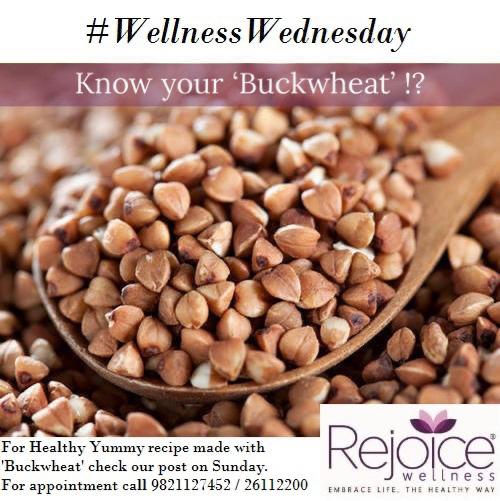Deprecated: implode(): Passing glue string after array is deprecated. Swap the parameters in /home/vlilwzgm/rejoicewellness.in/wp-content/themes/noo-medicus/framework/functions/noo-html-featured.php on line 626

#WellnessWednesday Know your Buckwheat!?
Deprecated: implode(): Passing glue string after array is deprecated. Swap the parameters in /home/vlilwzgm/rejoicewellness.in/wp-content/themes/noo-medicus/functions_custom.php on line 285
#WellnessWednesday
Buckwheat is a nutritious gluten free seed with toasty nutty flavor and soft chewy texture.
Buckwheat is referred to as a pseudo cereal because its seeds ‘culinary use is the same as cereals’ , owing to their composition of complex carbohydrates. The name “buckwheat” or “beech wheat” comes from its triangular seeds, which resemble the much larger seeds of the beech nut from the beech tree, and the fact that it is used like wheat.
Despite its name, buckwheat is not related to wheat and is thus gluten-free.
Buckwheat is mainly harvested in the northern hemisphere, especially in Russia, Kazakhstan, China, and Central and Eastern Europe. Buckwheat is also sold as flour, popularly known as kuttu ka atta in India. Nutrition facts
Nutrition facts for 3.5 ounces (100 grams) of raw buckwheat are:
• Calories: 343
• Water: 10%
• Protein: 13.3 grams
• Carbs: 71.5 grams
• Sugar: 0 grams
• Fiber: 10 grams
• Fat: 3.4 grams
The most abundant minerals in common buckwheat are; Manganese, Copper, Magnesium, Iron & Phosphorus.
Compared to other grains, the minerals in cooked buckwheat groats are particularly well absorbed because buckwheat is relatively low in phytic acid, a common inhibitor of mineral absorption found in grains and seeds.
Health benefits
– Buckwheat consumption shows improved blood sugar control. As a good source of fiber, buckwheat has a low to medium GI. This means that it should be safe to eat for most people with type 2 diabetes. This effect is thought to be due to the unique compound D-chiro-inositol. – Buckwheat may also promote heart health. It boasts many heart-healthy compounds, such as rutin, magnesium, copper, fiber, and certain proteins.Among cereals and pseudocereals, buckwheat is the richest source of rutin, an antioxidant that may have a number of benefits. Rutin may cut your risk of heart disease . – Buckwheat contains all nine essential amino acids, which are our body’s building blocks of protein. Thus Buckwheat helps in improving muscle health of our body.
– Buckwheat is rich in various antioxidant plant compounds, which are responsible for many of its health benefits. Quercetin is found in many plant foods, quercetin is an antioxidant that may have a variety of beneficial health effects, including lowering your risk of cancer.
Precaution:
Consumption of buckwheat is not associated with many adverse health effects. However, some people may be allergic. Symptoms may include skin rashes, swelling, digestive distress, and — in worst-case scenarios — severe allergic shock.

